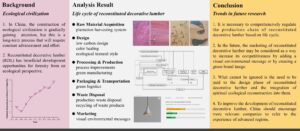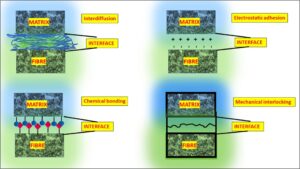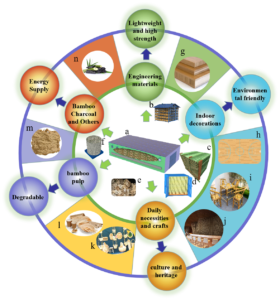Review Articles
Latest articles
- Reviewpp 5464-5484Zhou, C., Shi, Z., and Kaner, J. (2022). "Life cycle analysis for reconstituted decorative lumber from an ecological perspective: A Review," BioResources 17(3), 5464-5484.AbstractArticlePDF

In response to global Sustainable Development Goals (SDGs), the Chinese government has pledged to curtail increased carbon dioxide emissions beyond 2030 and to achieve carbon neutrality by 2060, thus achieving a status of an ecological civilization. Reconstituted decorative lumber, with rotary-cut (or planed) veneer from plantation or common species timber as the main raw material, has beneficial development opportunities for forestry from the perspective of an ecological civilization. This paper first discusses China’s current state of ecological civilization, then researches the various life cycles of reconstituted decorative lumber using the life cycle theory and provides a reference for the Chinese reconstituted decorative lumber industry’s development by analyzing progress in related fields. The eco-friendliness of reconstituted decorative lumber is explained via systematic combing, and proposals for the use and promotion of reconstituted decorative lumber in the new period are presented. Research and analysis findings show that it is necessary to comprehensively regulate the production chain of reconstituted decorative lumber based on life cycle. Research on the development and utilization of reconstituted decorative lumber needs to be strengthened. The promotion and marketing of reconstituted decorative lumber can be promoted by emphasizing its ecological significance.
- Reviewpp 5485-5509Zhou, Y., Xu, W., Pan, Y., Wang, F., Hu, X., Lu, Y., and Jiang, M. (2022). "Deep eutectic-like solvents: Promising green media for biomass treatment and preparation of nanomaterials," BioResources 17(3) 5485-5509.AbstractArticlePDF
Deep eutectic-like solvents (DESs) are recognized as environmentally benign media with highly tunable structures and properties. The usage of DES is promising in the field of biomass treatment and transformation, including pretreatment, selective dissolution, and separation of the main components. It serves as a green medium for modification of the biomass components, as well as preparation of biomass-derived nanomaterials. In this paper, the development on DES, including composition, properties, and characteristics was studied. The application of DES in biomass-derived nanomaterials is especially discussed. This review intends to provide references for adopting DES to improve biomass-based environmentally friendly nanomaterials.
- Reviewpp 5510-5531Clauser, N. M., Felissia, F. E., Area, M. C., and Vallejos, M. E. (2022). "Integrating the new age of bioeconomy and Industry 4.0 into biorefinery process design," BioResources 17(3), 5510-5531.AbstractArticlePDF

Manufacturing processes and their economy are dramatically evolving due to machinery and digital control improvements. Artificial intelligence, big data analytics, and the Internet of Things are key tools for this new industrial revolution era based on Industry 4.0. Bioeconomy and circular economy concepts have appeared in the forest, agriculture, food, pharmaceutical, pulp and paper, chemical, biotechnological, and energy areas, etc., to achieve sustainable economic growth development via biomass valorization in a biorefinery platform. Biorefinery process development at an industrial scale requires the previous design and assessment of processes and technologies. Therefore, economic, environmental, and social factors should be evaluated to prevent the failure in one of these issues that could affect the performance of the others. With a growing interest in sustainable economic development, there is a need to incorporate new technologies early enough in the process design. This study aims to better understand how Industry 4.0 era tools can bring new solutions to the biorefinery process design, in terms of the technical, economic, environmental, and social factors. Thus, these tools could improve and revolutionize the process selection optimization, provide alternatives for biomass valorization, integration strategies, and the metrics selection for process evaluation, adding the approach toward sustainable economic development.
- Reviewpp 5532-5556Wang, Q., Zhan, X., Wu, Z., Liu, X., and Feng, X. (2022). "The applications of machine vision in raw material and production of wood products," BioResources 17(3), 5532-5556.AbstractArticlePDF
Machine vision has been developed nearly for 70 years and been widely applied in electronics, automotive manufacturing, food processing, etc. With deepening study of its theory and technology in forestry industry, the industry of wood products is moving steadily toward the goal of automated identification and production to improve the manufacturing intelligence of enterprises. In this study, theoretical and algorithmic research on image acquisition, feature extraction, recognition, and classification involved in machine vision-based wood recognition technology were analyzed on the basis of its global development. The applications of machine vision in the wood materials, such as the identification of tree species, wood inspection and classification, defects detection of wood product, surface analysis of wood color, and quality control of furnishing products were thoroughly analyzed. The development trend of machine vision in the production and management of wood materials was considered in the current development of wood and furnishing enterprises. These results lay a solid foundation for wood science research, and intelligent manufacture of wooden furniture, and efficient development of greener and cleaner production of the furniture industry, which could improve the environmental effect of the wood products and furniture and make a great contribution for the carbon goal of “30-60” in China.
- Reviewpp 6997-7030Tazeddinova, D., Toshev, A. D., Abylgazinova, A., Rahman, M., Matin, M., Bin Bakri, M. K., and Ayan, O. (2022). "A review of polyphenol and whey protein-based conjugates," BioResources 17(4), 6997-7030.AbstractArticlePDF
Proteins act as a primary food component obtained from different food sources. In contrast, polyphenols are metabolites and are abundantly present in plants, so their combination plays a crucial role in defining the functional properties of a food product. In the current review, the protein-polyphenol interactions have been briefly reviewed, along with the changes that occur because of their interaction. The mechanisms and the factors affecting the functionalities of the protein-polyphenol conjugates, e.g., the solubility, antioxidant, and gelling properties, have also been briefly reviewed. In addition, the interaction of polyphenols with whey proteins was been reviewed with various applications within the food industry, e.g., emulsifiers, foaming agents, and antioxidants. To end the review, future challenges were also highlighted.
- Reviewpp 7031-7090Mohammed, M. M., Rasidi, M., Mohammed, A. M., Rahman, R. B., Osman, A. F., Adam, T., Betar, B. O., and Dahham, O. S. (2022). "Interfacial bonding mechanisms of natural fibre-matrix composites: An overview," BioResources 17(4), 7031-7090.AbstractArticlePDF

The development of natural fiber (NFr) composites for a variety of applications is on the rise. The optimization of the interfacial bonding (IFB) between the reinforcing NFr and polymer matrix is perhaps the single most critical aspect in the development of natural fibre polymer composites (NFPCs) with high mechanical performance. While the IFB is critical in determining the mechanical properties of the NFPCs, such as stress transfer, it is one of the least understood components. This article offers a summary of IFB mechanisms, different modification approaches targeted at lowering incompatibility and improving IFB, and evaluation of the impact of IFB. It has been found that 1) In general, interdiffusion, electrostatic adhesion, chemical reactions, and mechanical interlocking are accountable for the IFB; 2) the incompatibility of the fibre and matrix, which results in poor dispersion of the fiber, weak IFB, and ultimately worse composite quality, may be addressed through strategic modifications; and 3) Interfacial interactions between polymers and nanoparticles (NPs) are significantly improving their performance in areas like thermal, mechanical, robust IFB, and moisture absorption. As a result, this review study could be an important resource for scholars interested in coating and treating NFr to further enhance their surface characteristics.
- Reviewpp 7091-7109Jia, H., Fang, C., Liu, H., Zhang, X., Ma, X., Sun, F., and Fei, B. (2022). "Designing an improved strategy for Chinese warehouses to store bamboo and its semi-finished products," BioResources 17(4), 7091-7109.AbstractArticlePDF

Bamboo plants are fast-growing, quickly produce usable material, and are an abundant resource. Bamboo is an excellent, natural, and renewable material. It has a long history of application in human life, industrial manufacturing, cultural industries, and other fields. The warehousing of bamboo and its finished products is an emerging industry with much potential. A reasonable, stable, and orderly warehouse could be an effective solution for the sustainable management, seasonal harvesting, and raw material stability issues. In addition, the warehouse plays an important role in the processing of raw materials, reserve logistics, keeping a robust and real-time supply for downstream products. This is of great significance for alleviating problems associated with Chinese timber safety and for improving the quality of life. This paper focuses on warehousing experience in grain and coal fields, reviews the common material processing and preservation measures of bamboo, analyzes advantages and developmental prospects of bamboo warehousing, and explores and suggests appropriate storage methods, technical systems, and application models. It is expected to provide technical guidance for construction in the bamboo storage industry, and to supply ideas and suggestions for the modern development of the bamboo industry.
- Reviewpp 7110-7134Tazeddinova, D., Rahman, M. R., Hamdan, S. B., Matin, M. M., Bin Bakri, M. K., and Rahman, M. M. (2022). "Plant based polyphenol associations with protein: A prospective review," BioResources 17(4), 7110-7134.AbstractArticlePDF
This review discusses the classes of plant polyphenols along with their binding mechanisms with protein molecules. Generally, polyphenols bind in covalent and non-covalent orientations with protein molecules. Their addition to the protein usually results in undesirable flavors and tastes inside the proteins. They also affect the color of the food. Plant polyphenols are found to act in a protective way against cardiovascular disease, neurodegenerative diseases, diabetes, and cancer. In addition to redox activity, their modes of action include the inhibition of key enzymes, modulation of transcription factors or cell receptors, and finally, perturbation of protein aggregates. Dietary polyphenols usually play a key role in protein digestion by forming covalent and non-covalent bonds with proteins. In addition, polyphenols and plant phenolics possess the scavenging ability of reactive oxygen species (ROS), including radical/non-radical oxygen species including HOC•, H2O2, HOCl, 1O2 (singlet oxygen), and oxidatively generated radicals derived from LDL biomolecules such as ROOC• and oligonucleic acids.
- Reviewpp 7135-7166Kong, Y., and Fu, S. (2022). "Computer simulation in lignocellulosic biomass conversion processes: A review," BioResources 17(4), 7135-7166.AbstractArticlePDF
Much attention has been paid to the solubilization and conversion processes of cellulose, hemicellulose, and lignin to produce high value-added chemicals and fuels. Computer simulation shows great potential in understanding the conversion process of plant biomass. This paper reviewed the solubilization processes, catalytic conversion, and pyrolysis of cellulose, hemicellulose, and lignin by density functional theory and molecular dynamics. The authors also provide prospects for the challenges and future developments in this area.
- Reviewpp 7167-7249Hubbe, M. A., Szlek, D. B., and Vera, R. E. (2022). "Detergency mechanisms and cellulosic surfaces: A review," BioResources 17(4), 7167-7249.AbstractArticlePDF
The release of soils and impurities from cellulosic surfaces plays a critical role in such processes as the laundering of clothes and the deinking of wastepaper pulps. This article reviews publications that provide evidence about factors that affect such release and the mechanisms by which such factors operate. In general, cellulosic substrates provide advantages for the release of contaminants due to their hydrophilic nature and due to their permeability, allowing the transport of surfactants to contact interfaces with dirt. However, the same permeability of cellulosic material also provides opportunities for contaminants to work themselves into internal crevices and pores, from which they are difficult to remove. The article also reviews aspects of theory related to detergency and how those theories relate to the laundering, deinking, and purifying of substrates based on cellulose and related plant materials. Cellulose and some of its derivatives also can play a role in detergent formulation, especially as builders or as finishes placed on textile surfaces, which sometimes aid in the release of dirt.
